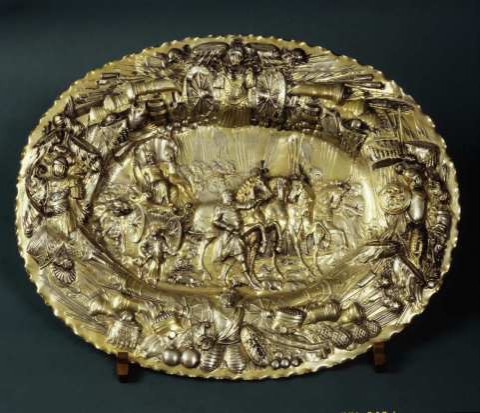Tray depicting the triumphal entry of king Jan III
karta katalogowa kolekcji
Rzemiosło artystyczne
Johann Gottfried Holl (fl. 1678-1689, workshop run by his widowed wife 1689-1701)
Gdańsk
1683
Gilded silver, repoussé, polished, containing half-relief elements
61 x 77 cm
Signage: goldsmith's stamp, City of Gdańsk stamp
Wil.500
Tray decorated with an all'antica scene on mirror, depicting King Jan III's triumphal return from the Siege of Vienna. Form alludes to the triumphs (i.e. solemn processions) of victorious Roman rulers. The royal couple are sitting, ancient style, in a four-wheeled chariot. The King, his head decorated with a laurel wreath symbolic of fame and glory, holds a regiment (military commander's mark of office) in his right hand. He is accompanied by the Queen as a person closest to the King's heart and one participating in the administration of royal power. The chariot, drawn by four horses, is led by city officials. The horses are symbolic of the virtues ascribed to the King: valour, intrepidity, commendable life and love of the fatherland. Next to the chariot, a Turkish captive is being led by a boy with a dog. The figure of the boy symbolizes obedience, submission, and the loyal love of the victorious king's subjects and donors of the tray. The edge of the tray is richly decorated with military trophies - suits of armour, cannons, lances, swords, banners, etc. The tray was made in the workshop of the Gdańsk goldsmith Johann Godfried Holl.
King Jan III, returning in glory from his Relief of Vienna, was welcomed by courtiers and officials on the Polish border. Those included two members of the Kraków city council, Adam Drużyński and Paweł Fryznekier, who represented the burghers of Kraków. According to tradition, they gave the King this silver tray, filled with gold, on his triumphal procession into Kraków on 23 December 1683. Another tradition states that the tray was given to the King by the citizens of Gdańsk during his six-month stay in the city.
The tray was kept in Wilanów in one of the wardrobes in the Royal Changing Room, where the so-called Polish antiquities were hold in addition to valuable European artworks and memorabilia of Jan III and his wife, Marie Casimire. It is now exhibited in the Royal Bedroom in the Palace of Wilanów.
Joanna Paprocka-Gajek

















